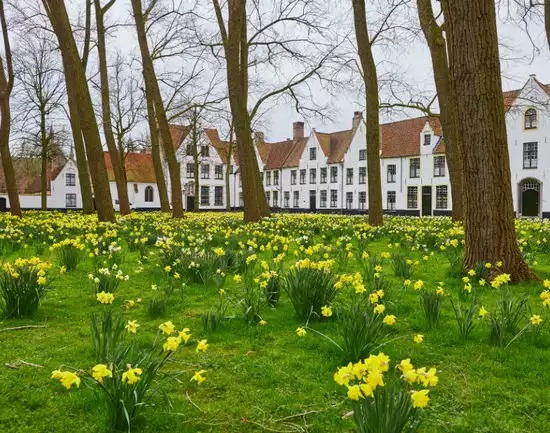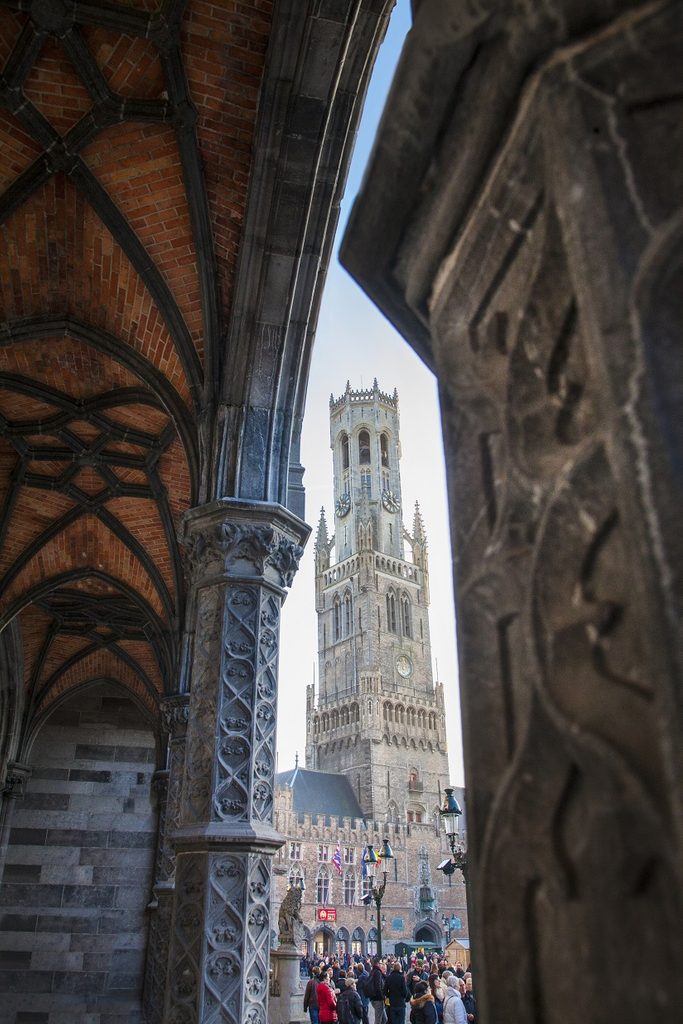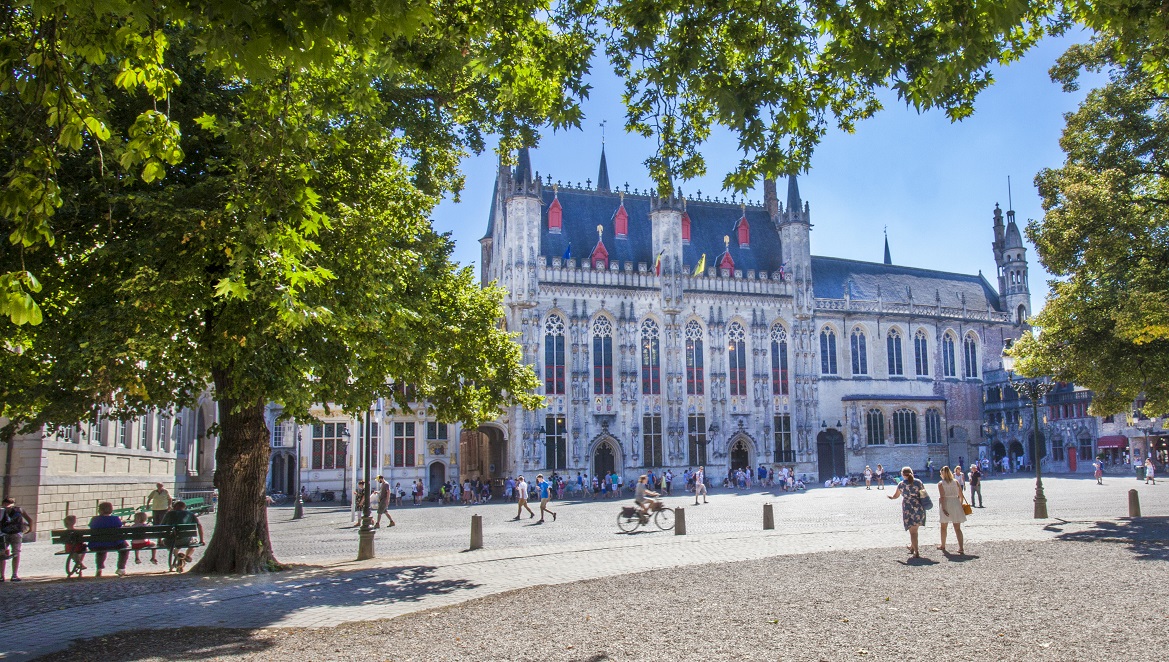Bruges has earned a reputation as one of Europe’s most charming cities due to its awe-inspiring medieval centre, cobbled streets, serene canals and magnificent edifices. Its entire historical centre has been recognised by UNESCO as a World Heritage Site, while its canals, which link Bruges to the North Sea, have earned it the soubriquet Venice of the North.
The city’s name first appeared in the 9th century, likely deriving from the old Germanic word 'brugj' meaning 'mooring'. In the early Middle Ages, Bruges turned into a bustling trade and political centre with a port and Flemish counts, who then ruled over the County of Flanders.
By the 13th century, Bruges was a top trading hub for north-western Europe and home to the world’s second stock exchange after Antwerp. As Flanders fell under the control of the Dukes of Burgundy, Bruges enjoyed a golden age in the 15th century, cultivating luxury goods and master painters, such as Jan van Eyck and Hans Memling, who became known as the Flemish Primitives. The riches flowing into Bruges funded the construction of impressive buildings, many of which still stand today.
The death in 1482 of Bruges’ ruler, Mary of Burgundy, who fell from her horse, ushered in a downturn. The Burgundian court and international traders left, sea access silted up and the port of Antwerp took over as the mercantile metropolis. By the time of Belgium’s independence in 1830, Bruges was a poor, provincial city.
Ironically, a book, Bruges la Morte (1892) by Georges Rodenbach, helped it turn the page. Readers rediscovered its heritage and tourism began. Plus, a new international seaport, Zeebrugge, was built. Bruges became one of the world's top tourist destinations, attracting wealthy British and French visitors.
Bruges has remained prosperous in the 21st century thanks to tourism. Today, it attracts about nine million visitors a year from around the world – arguably too much for a population of only 120,000. The city is addressing the challenges of over-crowding and over-tourism, but it is sill, it is best to visit Bruges in the less crowded spring or fall.
UNESCO Heritage
Bruges boasts six UNESCO heritage recognitions – a lot for a city of its size – helping Belgium reach fifth place in ranking of World Heritage Sites per square kilometre (15).
Bruges’ beguinage was the first to be recognised as World Heritage amongst Flemish beguinages in 1998; followed by the Belfry (Belfort) under Belfries of Belgium and France one year later; and then its entire historical city centre in 2000. Intangible Cultural Heritage recognitions followed with the Procession of the Holy Blood in Bruges in 2009, carillon culture in 2014 and beer culture in Belgium in 2016.

The Bruges beguinage
Beguinages are religious communities for single women and one remains in Bruges today: Princely Beguinage Ten Wijngaarde. Founded in 1245, it is inhabited by nuns of the Order of St. Benedict and other single women. Its white-coloured houses peek behind large trees, grass and spring flowers like daffodils and crocuses. It’s a peaceful escape from tourist-laden streets.
The Belfry, an 83-metre-high bell tower from the 13th century, offers stunning views of Bruges if you’re willing to climb 366 steps to the top. On the way up, you can see a former treasury, the clock interior and the music drum that plays the tower’s 47 bronze, carillon bells.

Tower from the colonnade
Belgian carillon culture is on UNESCO’s Register of Good Safeguarding Practices to preserve the art of making music with bells. It is performed by carillonneurs, traditionally during market and festive days. But the sound of carillons can be heard around Bruges all the time. The Belfry in the heart of the city is the best place to hear them, either from its rear courtyard or the Market Square (Markt).
It is unusual for an entire city to receive UNESCO recognition, but Bruges’ historical centre made the grade because of its well-preserved medieval heritage – and its location as the birthplace of the Flemish Primitives. The city’s architectural unity is marked by Gothic brick buildings. The Market Square includes the Belfry, Provincial House, colourful guildhalls and Historium. Nearby Burg Square has the stunning City Hall (Stadhuis), Liberty of Bruges (Brugse Vrije) with the former law court with a famous wooden mantelpiece, and 12th century, Romanesque-style Basilica of the Holy Blood. Other medieval highlights are the Church of Our Lady Bruges (Onze-Lieve-Vrouwekerk), four city gates and almshouses (godshuizen). The latter were a form of public housing for elderly people or widows in the 14th century and today, 43 of 46 preserved blocks of these small, white-washed houses are still occupied by the elderly.
The Basilica of the Holy Blood houses a relic of the blood of Jesus Christ. Since 1304, this relic has been carried around Bruges in the UNESCO-recognised Holy Blood Procession every Ascension Day as an expression of gratitude and faith. More than 1,700 participants dressed in medieval costumes sing, play music, dance and act during the event.
UNESCO recognition extends to Belgium’s diverse beer culture, which permeates throughout Bruges. The city has its own beer (Brugse Zot, which is also a nickname for locals), two breweries (Brouwerij De Halve Maan and Bourgogne des Flandres), a beer museum (Bruges Beer Experience), an annual festival as well as shops, bars and restaurants dedicated to beer culture. For example, many restaurants cook with local beers.
Medieval to modern art
During its golden 15th century, Bruges was the epicentre of Flemish art. Masterpieces by the Flemish Primitives can be viewed in the Groeninge Museum, St John’s Hospital (Sint-Janshosptitaal, closed for renovation until December 16, 2023), St Saviour’s Cathedral (Sint-Salvatorskathedraal) and Museum of the Church of Our Lady. Bonus: the latter includes Michelangelo’s Madonna and Child sculpture (recovered twice after being stolen by Napoleon and Hitler), plus painted tombs from the 13th century.
The 15th century Gruuthuse Museum in a former palace houses impressive tapestries, colourful stained-glass windows and tiles, wooden sculptures and ceilings, historic lace and Burgundian manuscripts. It includes an oratory that overlooks the Gothic chancel of the Church of Our Lady and a balcony with a fantastic view of the famous Bonifacius Bridge. Hof Bladelin, a small museum in a historic mansion, shows medieval life in Bruges via artwork, furniture and everyday objects.
Lacemaking, developed in the early 16th century, remains a popular tradition in Bruges. The Lace Centre & Museum (Kant Centrum), located in a former lace school, displays basic techniques and movements, types of lace and their geographical origins, and more. It also has bobbin lace-making demonstrations every afternoon (except Sundays and holidays) as well as courses and a quality label ‘Handmade in Bruges’.
On the modern art side, the Groeninge Museum has great examples by Belgian artists like René Magritte, Paul Delvaux, Jean Brusselmans, Marcel Broodthaers and Constant Permeke. (Near the museum is a charming, little park with a white gazebo.) The Museum-Gallery XPO Salvador Dalí, located in the base of the Belfry, exhibits more than 300 works by the Spanish surrealist from a private collection. It includes paintings, sculptures, engravings and furniture.
Contemporary visual and sound art is featured in the Concertgebouw, a performing arts and cultural centre. The Concertgebouw Circuit is a one-tour of art and architecture, including a stop on the rooftop for panoramic views of the city.
In 2025, a new art centre called BRUSK will open to host temporary exhibitions of international importance. It’s the crux of a master plan by the City of Bruges, Musea Brugge and Flanders to enhance art and culture in Bruges. The plan also includes the renovation of the Groeninge Museum.
Religious Architecture
As a medieval city, Gothic churches are dominant in Bruges. The best known is the Church of Our Lady, which is the city’s tallest building, flanked by flying buttresses from the late 1200s. Its 115-metre-high spire is the third tallest brick tower in the world. Its stunning Baroque interior includes black and white tiled flooring and a chapel built in 1482 for a wealthy man named Lodewijk van Gruuthuse (hence, his namesake museum). The church also contains mausoleums of Charles the Bold, the Duke of Burgundy, and his daughter, Mary of Burgundy, both of whom reigned during Bruges’ golden era.
Nearby is the well-preserved St Saviour’s Cathedral, the main church of the city, which evolved from a parish church in the 10th century to a cathedral in the 19th with few signs of ageing. St James Church (Sint-Jakobskerk) complements the Church of Our Lady as another outstanding example of 13th century architecture, which was expanded and patronised by the Duke of Burgundy.

Jan van Eyck Square
Often overlooked by tourists are Jerusalem Chapel, home to a series of 15th century frescoes depicting the life of Christ, St Anne’s Church with a stunning Baroque interior and St Giles Church, where great Bruges artists like Memling are buried. While off the beaten path, these churches are walkable from the city centre. Moreover, Bruges is dotted with statues of largely religious figures on building corners. It’s like a treasure hunt to discover them around the city.
While not religious, the Bruges Royal Municipal Theatre is worth passing by for its stately 19th century Baroque architecture. And don’t miss the gorgeous, white gilded archway on little Blind Donkey Street (Blinde-Ezelstraat) off Burg Square.
Canals and windmills
In addition to its historic landmarks, Bruges is equally known for its beautiful canals, which reflect buildings and landscapes. That’s why boat tours abound and people crowd at the Rosary Quai (Rozenhoedkaai) viewing spot.
The Minnewater (Lake of Love) area is also very picturesque with a castle (Kasteel Minnewater), park, swan-filled waterways, Lovers' Bridge and Gunpowder Tower. There are restaurants, terraces and picnic areas in between for people to embrace the romance of the surroundings. Another great way to enjoy the landscape of Bruges, plus escape tourists, is by hot air balloon. Plentiful horse-drawn carriages, however, will take you right through the crowds.
While canals are a hallmark of Bruges, windmills have also been part of its history. Today four remain, two of which still grind grain. Sint-Janshuis Mill, constructed in 1770, can be visited (except during winter). A Musea Brugge Card (museabrugge.be) gives 72 hours of access to this and 12 other heritage sites at a reduced price. The Belgian Museum Pass works at many sites as well. The windmills, along with the old city gates, are the last of the city ramparts (De Vesten). The former city wall is now 26 hectares of green space for walking or cycling. There is a 7km pathway just for that, along which lie the four medieval gates and an artsy, red bridge at Barge Square.
Gastronomy
Belgium is known for beer, chocolate, waffles and fries and Bruges has no shortage of them. There are many places to taste and buy these indulgences.
The Bruges Beer Experience informs about beer types, the brewing process, food pairing and more in an innovative way. The Duvelorium Grand Beer Café inside the Historium offers a great view of the Markt and cool, branded artwork. Many bars offer a variety of beers, some of which are brewed locally or by Trappist monks in nearby monasteries.
Chocolate lovers can indulge in several artisanal chocolate shops, though quality varies (look for those that make their chocolate on site and/or are a member of the Guild of Bruges Chocolatiers). Choco-Story, the chocolate museum, tells about chocolate production and its importance in Belgian culture as well as offers one-hour praline-making workshops.
The Belgian Fries (Friet) Museum, which claims to be the only of its kind in the world, features the history of potatoes, invention of fries in Belgium and how they are made. You can taste samples of fries (or chips, if that’s what you call them) in the museum’s shop.
SEE
- Carillon concerts: Wed, Sat and Sun at 11am-12pm, The Belfry, Market Square. These are even livestreamed on facebook.com/CarillonBrugge
- Harp concerts: Wed-Sat at 3, 5 and 6:30pm, Oud Sint Jan, harpist Luc Vanlaere plays free 40-minute spiritual concerts on harps from around the world, harpmuziek.be
- Procession of the Holy Blood: May 18 Ascension Day, arguably Bruges' most famous event, this annual religious procession dating back to 1304 features historic costumes, music and religious artifacts. It is UNESCO Intangible Cultural Heritage, bloedprocessiebrugge.be
- Bruges Beer Festival: June 10-11, celebration of the city's rich beer culture with tastings, workshops and events, brugsbierfestival.be
- Cactus Festival: July 7-9, music festival with local and international artists performing in Minnewater Park, cactusfestival.be
- We Can Dance: Aug 5-6 and 12-13, Tomorrowland-like festival on the beach in Zeebrugge with electronica music and fashion. This year’s theme, Sea, Sand & Sun, invites everyone to channel their inner mermaid, wecandance.be
- Reie Festival: Aug 18-20, a new arts festival that connects heritage and history with contemporary performing arts at open-air sites around canals, reiefestival.be
- Winter Glow: end Nov-early Jan, winter festival with a ‘light experience’ trail, Christmas market and artificial ice-skating rink, visitbruges.be/en/winter
- Bruges Triennial: summer 2024, art and architecture event every three years featuring installations and exhibitions city-wide by established and emerging artists, triennalebrugge.be
SAVOUR
- Cafedraal: Stylish restaurant in a converted church with high ceilings and stained-glass windows featuring modern European cuisine and an extensive wine list, cafedraal.be
- De Verloren Hoek: New pub featuring world cuisine in a cosy atmosphere, deverlorenhoek.com
- Franco Belge: Founded by two young chefs, a modern restaurant featuring traditional French and Belgian cuisine with a contemporary twist, restaurantfrancobelge.be
- Lieven: Upscale Flemish bistro that has “honest and pure cuisine” with seasonal products, etenbijlieven.be
- 't Zwart Huis: Serving classic Belgian cuisine and exotic meats (think kangaroo), this restaurant in a historic building features local and organic ingredients as well as live music, bistrozwarthuis.be
SIP
- Café Vlissinghe: One of the oldest bars in Bruges dating to 1515, this café off the beaten path is well-preserved with old wooden beams, tiled floors and antique furnishings, cafevlissinghe.be
- Cuvée: An insider’s place, this organic-friendly wine bar and shop has a hidden restaurant in the back with gourmet snacks, cuvee.be
- De Halve Maan Brewery: Historic brewery with tours, tastings and dining indoors by a fireplace or outdoors in a medieval courtyard surrounded by modern art and old brewing equipment. It offers nine beers and three brands, including Brugse Zot, halvemaan.be
- Frans Restaurant Kasteel Minnewater: Romantic spot for a drink, especially on its outdoor terrace, with one of the city’s best views overlooking the Lake of Love
- Le Trappiste Brugge: Lively bar serving up Trappist beers from Belgium and beyond in an underground Medieval setting with archways, letrappistebrugge.com
STAY
- Hotel Van Cleef: Swanky, five-star hotel in a historic building away from the tourist centre, features stylish rooms and suites, a spa and canal-side terrace, hotelvancleef.be
- Hotel Heritage: Five-star hotel in a historic building near the Markt offering elegant rooms and suites, a spa, fitness centre and gourmet restaurant (Le Mystique), hotel-heritage.com
- Hotel de Orangerie: Charming four-star hotel in a 15th century building overlooking canals with cosy rooms and suites, a courtyard garden and private boat for canal tours, hotelorangerie.be
- Dukes’ Arches: Four-star, adults-only boutique hotel in a 19th century mansion with newly renovated rooms and suites, a spa and private courtyard garden, dukesarches.com. Sister properties are Hotel Dukes’ Palace, Dukes’ Palace Residence. and soon-to-be Dukes’ Academie.
- ‘t Fraeyhuis: New four-star, adults-only boutique hotel in a historical building in Minnewater Park with an outdoor restaurant and bar that features live music, fraeyhuis.be
- De Barge Boat Hotel Restaurant: Unique, three-star hotel on a renovated barge moored in a canal, features cosy cabins, a restaurant and sun terrace, hoteldebarge.be
SHOP
- 'T Apostelientje: One of the only shops in Bruges offering hand-made lace, including antique, vintage and contemporary designs, apostelientje.be
- Chocolaterie Sukerbuyc: One of the oldest and best artisanal chocolate makers in Bruges, run by a third-generation family and on Gault & Millau’s list of fine chocolatiers, sukerbuyc.be
- De Witte Pelikaan: It’s Christmas year-round at this decoration shop, which is the first of its kind in Belgium, housed in a Renaissance building topped with a white pelican, dewittepelikaan.be
- Marie Brat: Couture shop with casual wear and accessories for women
- The Bottle Shop: Near the Market Square, this retailer of all things beer sells more than 600 types of Belgian beer with glasses to match, thebottleshop.be

